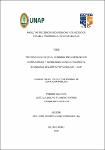Impuesto selectivo al consumo en el mercado de combustibles y su relación con el crecimiento económico de Loreto periodos 2007 - 2019

View/
Date
2022Author
Filomeno Torres, José Alejandro
Rios Hidalgo, Solano
Metadata
Show full item recordAbstract
The purpose of the study was to estimate the relationship, through correlation coefficients, between the selective tax on fuel consumption and the economic growth of the Loreto region, during the period 2007 and 2019. For this, quantitative analyzes were carried out, using statistics descriptive and through inferential statistics, through two statistical models to calculate, evaluate and analyze the correlation coefficients of the variables, these were the Pearson correlation model and the Spearman correlation model. Our results show that investment is positively correlated with economic growth and that this correlation is good with a correlation coefficient of 0.63, the variable Public Expenditure is also positively correlated with economic growth and is a good correlation, even higher to the correlation of investment and economic growth, with a correlation coefficient of 0.76, but the selective consumption tax has a positive but low correlation with economic growth, which is 0.065, unemployment has a negative correlation with growth economy of Loreto. Given our results, we can validate both our general and specific hypotheses, since we demonstrate quantitatively that the selective consumption tax has a direct relationship with economic growth, and public spending, tax collection and investment have a positive relationship with economic growth. in Peru, during the period 2007 - 2019. El propósito del estudio fue estimar la relación, a través de coeficientes de correlación entre el impuesto selectivo al consumo de combustibles y el crecimiento económico de la región de Loreto, durante el periodo 2007 y 2019. Para ello, se realizaron análisis cuantitativos, mediante estadística descriptiva y mediante estadística inferencial, a través de dos modelos estadísticos para calcular, evaluar y analizar los coeficientes de correlación de las variables, estas fueron el modelo de correlación de Pearson y el modelo de correlación de Spearman.
Nuestros resultados muestran que la inversión está correlacionada positivamente con el crecimiento económico y que esta correlación es buena con un coeficiente de correlación de 0.63, la variable Gasto público, también se correlaciona de manera positiva con el crecimiento económico y es una correlación buena, incluso superior a la correlación de la inversión y el crecimiento económico, con un coeficiente de correlación de 0.76, pero el impuesto selectivo al consumo tiene una correlación positiva pero baja con el crecimiento económico, que es de 0.065, el desempleo posee una correlación negativa con el crecimiento económico de Loreto.
Dado nuestros resultados, podemos validar nuestras hipótesis tanto general, como las especificas pues demostramos cuantitativamente que el impuesto selectivo al consumo posee una relación directa con el crecimiento económico, y gasto público, la recaudación tributaria y la inversión poseen una relación positiva con el crecimiento económico en el Perú, durante el periodo 2007 – 2019.
Collections
- Tesis [341]

